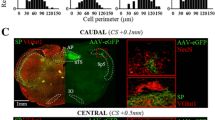Summary
Carotid bodies of ducks show no detectable changes in ultrastructure up to periods of four weeks following the removal of 2–3 cm of the cervical vagus (decentralization). This indicates that the majority, and possibly all the nerves terminating on the glomus cells are afferent (sensory) in nature. These nerve endings are in reciprocal synaptic contact with the glomus cells and therefore have efferent and afferent functions. Theories concerning the carotid body receptor mechanism are discussed with particular reference to those theories which ascribe functions to the reciprocal synapses.
Similar content being viewed by others
References
Astrand, P.-O., Christensen, E.H.: The hyperpnoea of exercise. In: D.J.C. Cunningham and B.B. Lloyd (Editors), The Regulation of Human Respiration, 515–524 (1963). Oxford: Blackwell Scientific Publications
Bayliss, L.E.: Living Control Systems, London: English Universities Press 1966
Belmonte, C., Eyzaguirre, C.: Efferent influences on carotid body chemoreceptors. J. Neurophysiol. 37, 1131–1143 (1974)
Biscoe, T.J.: Carotid body: Structure and function. Physiol. Rev. 51, 437–495 (1971)
Biscoe, T.J., Stehbens, W.E.: Ultrastructure of the carotid body. J. Cell Biol. 30, 563–578 (1966)
Biscoe, T.J., Sampson, S.R., Purves, M.J.: Stimulus response curves of single carotid body chemoreceptor afferent fibres. Nature 215, 654–655 (1967)
Biscoe, T.J., Sampson, S.R.: Rhythmical and non-rhythmical spontaneous activity recorded from the central cut end of the sinus nerve. J. Physiol. 196, 327–338 (1968)
Biscoe, T.J., Lall, A., Sampson, S.R.: Electron microscope and electrophysiological studies on the carotid body following intracranial section of the glossopharyngeal nerve. J. Physiol. 208, 133–152 (1970)
Biscoe, T.J., Pallot, D.: Serial reconstruction with the electron microscope of carotid body tissue. The type 1 cell nerve supply. Experientia 28, 33–34 (1972)
Bouverot, P., Leitner, L.-M.: Arterial chemoreceptors in the domestic fowl. Respir. Physiol. 15, 310–320 (1972)
Bouverot, P., Hill, N., Jammes, Y.: Ventilatory responses to CO2 in intact and chronically chemodenervated Peking ducks. Respir. Physiol. 22, 137–156 (1974)
Chowdhary, D.S.: A comparative study of the carotid body and carotid sinus of vertebrates. II. The carotid body and carotid sinus of the fowl (Gallus domesticus). Ph.D. Thesis, University of Edinburgh (1953)
De Castro, F.: Sur la structure et l'innervation du sinus carotidien de l'homme et des mammifères. Nouveaux faits sur l'innervation et la fonction du glomus caroticum. Trab. Lab. Invest. biol., Univ. Madr. 25, 330–380 (1928)
Eyzaguirre, C., Zapata, P.: A discussion of possible transmitter or generator substances in carotid body chemoreceptors. In: (R.W. Torrance, ed.). Arterial Chemoreceptors. Oxford: Blackwell Scientific Publications 213–247 (1968)
Eyzaguirre, C., Nishi, K., Fidone, S.: Chemoreceptor synapses in the carotid body. Fed. Proc. 31, 1385–1393 (1972)
Goodman, N.W.: Efferent control of arterial chemoreceptors mediated by glossopharyngeal fibres and artifacts introduced by stimulation techniques. J. Physiol. 230, 295–311 (1973)
Hellström, S.: Morphometric studies of dense-cored vesicles in type 1 cells of rat carotid body. J. Neurocytol. 4, 77–86 (1975)
Hess, A., Zapata, P.: Innervation of the cat carotid body: normal and experimental studies. Fed. Proc. 31, 1365–1382 (1972)
Howe, A., Neil, E.: Arterial chemoreceptors. Handbook of Sensory Physiology 3, 47–80. Berlin, Heidelberg, New York: Springer Verlag 1972
Ishii, K., Oosaki, T.: Fine structure of the chemoreceptor cell in the amphibian carotid labyrinth. J. Anat. 104, 263–280 (1969)
Jones, D.R., Purves, M.J.: The effect of carotid body denervation upon the respiratory responses to hypoxia and hyperoxia in the duck. J. Physiol. 211, 295–309 (1970a)
Jones, D.R., Purves, M.J.: The carotid body in the duck and the consequences of its denervation upon the cardiac responses to immersion. J. Physiol. 211, 279–294 (1970b)
Kobayashi, S.: Comparative cytological studies of the carotid body 2, Ultrastructure of the synapses on the chief cell. Arch. histol. jap. 33, 397–420 (1971)
Kobayashi, S., Uehara, M.: Occurrence of afferent synaptic complexes in the carotid body of the mouse. Arch. histol. jap. 32, 193–201 (1970)
Kondo, J.: An electron microscopic study on innervation of the carotid body of guinea pig. J. Ultrast. Res. 37, 544–562 (1971)
McDonald, D., Mitchell, R.A.: The innervation of glomus cells, ganglion cells and blood vessels in the rat carotid body: a quantitative ultrastructural study. J. Neurocytol. 4, 177–230 (1975)
Metz, B.: Release of ACh from the carotid body by hypoxia and hypoxia plus hypercapnia. Respir. Physiol. 6, 386–394 (1969)
Mitchell, R.A., Sinha, A.K., McDonald, D.M.: Chemoreceptor properties of regenerated endings of the carotid sinus nerves. Brain Res. 43, 681–685 (1972)
Neil, E., O'Regan, R.G.: The effects of electrical stimulation of the distal end of the cut sinus and aortic nerves on peripheral chemoreceptor activity in the cat. J. Physiol. 215, 15–32 (1971a)
Neil, E., O'Regan, R.G.: Efferent and afferent impulse activity recorded from few-fibre preparations of otherwise intact sinus and aortic nerves. J. Physiol. 215, 33–47 (1971b)
Nishi, K., Stensaas, L.J.: The ultrastructure and source of nerve endings in the carotid body. Cell Tiss. Res. 154, 303–319 (1974)
O'Regan, R.G.: Efferent inhibition of the chemoreceptor activity of the ischaemic carotid body. J. Physiol. 239, 95P-96P (1974)
Osborne, M.P., Butler, P.J.: New theory for receptor mechanism of carotid body chemoreceptors. Nature 254, 701–703 (1975)
Sampson, S.R.: Mechanism of efferent inhibition of carotid body chemoreceptors in the rat. Brain Res. 45, 266–270 (1972)
Sampson, S.R., Biscoe, T.J.: Efferent control of the carotid body chemoreceptor. Experientia 26, 261–262 (1970)
Torrance, R.W.: Prolegemma. In (R.W. Torrance, ed.) Arterial Chemoreceptors. Oxford: Blackwell Scientific Publications 1–40 (1968)
Verna, A.: Terminaisons nerveuses afférentes et efférentes dans le glomus carotidien du lapin. J. Microscopie 16, 299–308 (1973)
Werblin, F.S.: Regenerative hyperpolarization in rods. J. Physiol. 244, 53–82 (1975)
Zapata, P.: Effects of dopamine on carotid chemo- and baroreceptors. J. Physiol. 244, 235–252 (1975)
Author information
Authors and Affiliations
Additional information
The authors wish to thank Mrs J. Birch for her technical assistance. This work was supported by grants from the S.R.C.
Rights and permissions
About this article
Cite this article
Butler, P.J., Osborne, M.P. The effect of cervical vagotomy (decentralization) on the ultrastructure of the carotid body of the duck, Anas platyrhynchos . Cell Tissue Res. 163, 491–502 (1975). https://doi.org/10.1007/BF00218494
Received:
Issue Date:
DOI: https://doi.org/10.1007/BF00218494




